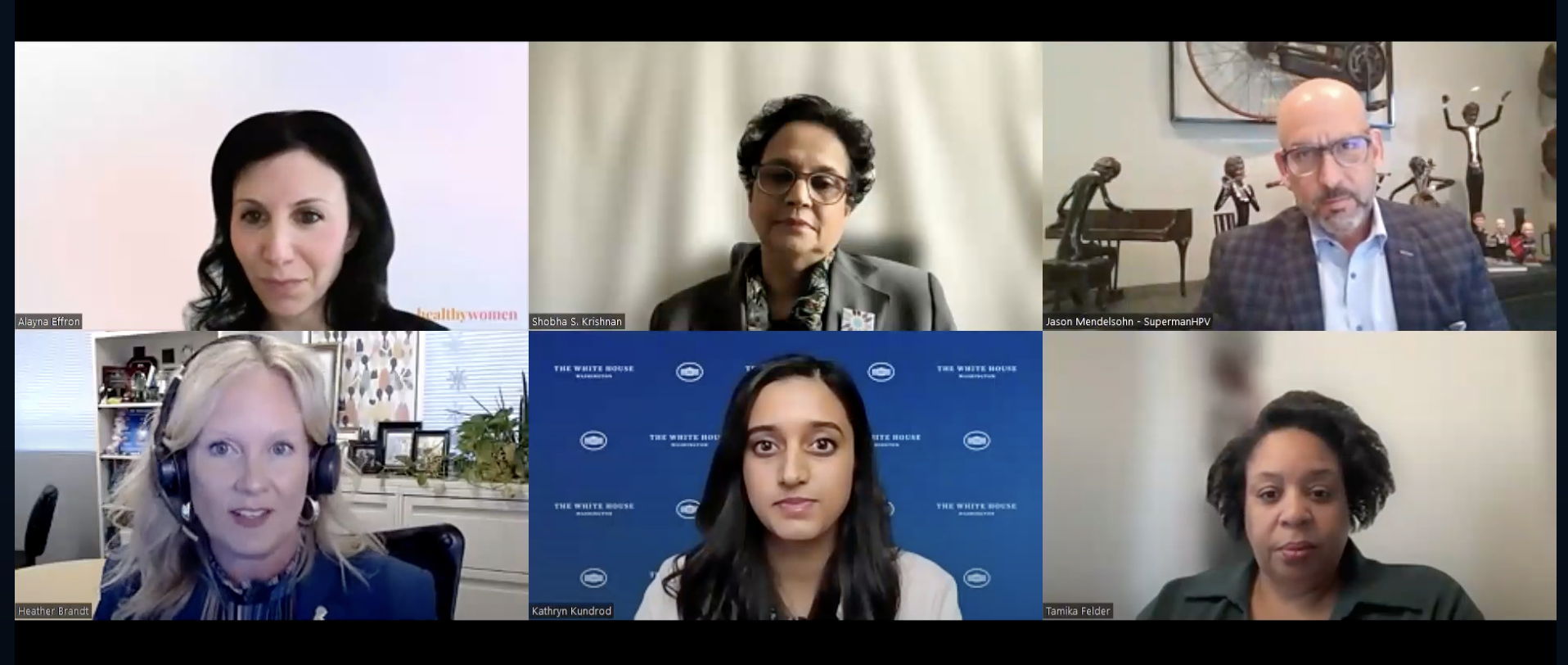Alayna Effron, EdD, Msc., CHES, Director of Development at HealthyWomen, (top left) leads a panel on cervical cancer during a HealthyWomen webinar.
By Bria Fitz, MA, SWHR Public Policy Fellow
How can we spread awareness and increase access to vaccines for the human papillomavirus (HPV)? What stops parents from getting their children vaccinated for HPV? How can we increase access to HPV-related cervical cancer screenings? These were some of the central questions posed during HealthyWomen’s Congressional Briefing on Preventing HPV-Related Cancers through Vaccination and Screening. The event was held on January 24, 2024, in recognition of HPV Prevention Week and Cervical Cancer Awareness Month.
The briefing began with messages from Representatives Kathy Castor (D-FL), Julia Letlow (R-LA), and Kim Schrier, MD (D-WA). The three congresswomen are co-sponsors of a bipartisan bill that would help educate the public about HPV vaccines and increase resources for cervical cancer screenings. The bill is called the PREVENT HPV Cancers Act, or the Promoting Resources to Expand Vaccination, Education and New Treatments for HPV Cancers Act. According to Rep. Castor, “We want parents and pediatricians to protect boys and girls from a future cancer diagnosis and understand the best age to get vaccinated.”
Since the beginning of the coronavirus pandemic, vaccine misinformation has grown while rates of immunization for a variety of diseases, along with rates of cancer screenings, dropped. The congresswomen highlighted the public health harms of declining screenings and immunizations, with Rep. Schrier reminding attendees that “immunizations are one of the greatest public health tools we have, and they work best when there’s widespread use.” Rep. Schrier also addressed the discomfort parents may have with giving the HPV vaccine to children at a young age and the myth that it will encourage teenage promiscuity. According to the Society of Behavioral Medicine, there is no evidence that the HPV vaccine is linked with higher sexual activity. Further, doctors recommend the HPV vaccine be given between ages 9 and 12 to children of all genders because it is more effective at a younger age before sexual activity begins. HPV can also be spread non-sexually, though that is a less common mode of transmission.
The five panelists who spoke during the event were cancer survivors, doctors, and researchers. Multiple panelists emphasized the fact that HPV causes six types of cancers, including oral cancer and cervical cancer, resulting in about 36,000 cancer cases every year in the United States. However, over 90% of HPV-related cancers are preventable through vaccination, said Dr. Shobha Krishnan, founder and president of the Global Initiative Against HPV and Cervical Cancer. Dr. Krishnan went on to say that cervical cancer is almost 100% preventable through HPV vaccination, screening, and treatment.
While HPV and HPV-related cancers affect all genders and all types of people, there are disproportionate impacts. Dr. Kathryn Kundrod, a senior coordinator with the White House Cancer Moonshot initiative, cited cervical cancer as the second leading cause of cancer death in women aged 20 to 39 years. Black, Hispanic, and American Indian women in the United States are more likely to be diagnosed and die from cervical cancer than White women. Low-income women and LGBTQ+ people also have higher rates of cervical cancer.
Immunization and education are key to ensuring that more women and girls can live long, healthy lives.
“No one has to die of cervical cancer. No one has to die of HPV-related cancers. We can stop this.” Tamika Felder, Chief Visionary of Cervivor, Inc. and cancer survivor
How can we create change? Dr. Heather Brandt, director of the HPV Cancer Prevention Program at St. Jude Children’s Research Hospital, laid out a five-point action plan for preventing HPV-related cancers:
- Get vaccinated against HPV
- Get your children vaccinated
- Encourage others to get vaccinated
- Share information about how safe and effective the HPV vaccine is
- Support the PREVENT HPV Cancers Act
Watch the full congressional briefing from HealthyWomen here.
